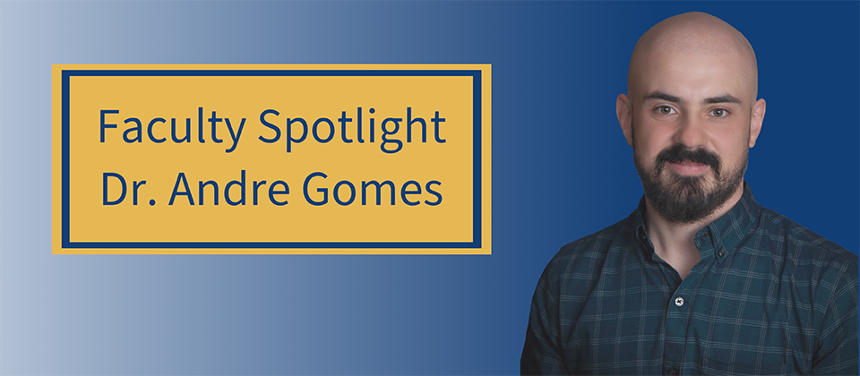Faculty Spotlight: Dr. André Gomes
Faculty Spotlight: Dr. André Gomes
Faculty Spotlight: Dr. André Gomes
Rowan is racing to R1, and the computer science department is leading the charge! To keep up with the university’s rapid expansion, the department has continued to bring on new faculty—including a new assistant professor, Dr. Gomes.
Dr. André Gomes is a newcomer to the department this semester. He is an assistant professor of computer science, and joined us because of our rising presence in research. He earned his Ph.D in Computer Engineering from Virginia Tech, and has a masters in Computer Science from the Federal University of Minas Gerais. Dr. Gomes is from Brazil. He is also a member of the Institute of Electrical and Electronics Engineers, or IEEE. In his spare time, he enjoys hiking, biking, and road trips, culminating in a love for travel. He’s been all over the world, to places like Ireland and Australia.
This semester, Dr. Gomes is teaching Introduction to Object Oriented Programming, or IOOP, and plans to teach it next semester. In his class, he’s looking for students with a sense of independence; students willing to practice what they’ve learned outside of the classroom. Dr. Gomes is a hands-on instructor, always providing examples along with his lessons. “[Examples] are an opportunity for students to realize they need more clarification on what they’re doing.
Dr. Gomes is most interested in computer networking and has his background in wireless communication. He is particularly interested in how networks can be designed to be as reliable as possible, with a nearly 99.999% certainty that it will withstand nearly any network adverse condition. Ultra-reliable communication is crucial when it comes to certain types of wireless communication services, such as remote-controlled or self-driving vehicles. “For a remote-controlled vehicle, you need (ultra-)reliable networks that can operate at long distance, with the shortest possible delay. If you need to tell a truck to turn right, even a sporadic five second delay would be catastrophic—it would not only miss its turn but potentially crash into something else,” says Gomes. “In order to build those networks, we need to look into any event that could possibly disrupt the network, even if it has a less than one-thousandths of a chance of happening. For example, if there are multiple big trucks on either side of the remote-controlled vehicle, blocking its communication, if it’s hailing—you have to account for everything,” he continues.
Dr. Gomes also works with reconfigurable intelligent surfaces. They’re wallpaper-like surfaces whose physical properties can be manipulated to affect how wireless signals are reflected. “It allows you to control the signal, so you can boost it or redirect it, but you can also bounce them off the walls in such a way that you jam the receivers and break communications,” says Gomes. “I look specifically at this interference; how can we jam the receivers, so we can learn to build the receivers back up stronger, to be more resistant to malicious attacks.”
As an active member of IEEE, Dr. Gomes not only reviews papers but submits his own research every year. He’s a prolific researcher, with his most recent piece, “Analysis of spectrum needs for network-wide ultra-reliable communication with network sharing,” winning the Best Paper Award at the 2023 IEEE Globecom conference. Dr. Gomes has three new papers that will debut at this year’s Globecom. The first paper covers how applied machine learning can be used to break beam wireless protocols for controlling reconfigurable intelligence surfaces. The second looks at optimization technology to break coding protocols that reintroduce interference with reconfigurable intelligent surfaces to degrade wireless communications. The third is an assessment of OpenRAN's new mobile network architecture and its impact on network resiliency. “What makes my research most exciting was the people I work with on each paper,” Gomes says. “They’re from different corners of the world—Virginia Tech, University of Oulu, New York University, AT&T research labs—I get to hear many different ideas from many different people.”
Dr. Gomes wants to get more involved with the student community here on campus. “I want to find students interested in computer networking, and work more with Latino students on campus,” says Gomes. Any student interested in reaching out can contact him at gomesa@rowan.edu.
We at the computer science department give our warmest welcomes to Dr. Gomes!
Written by Kiley Parker | Posted 10.18.24
